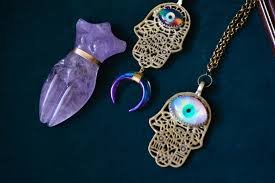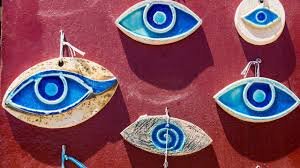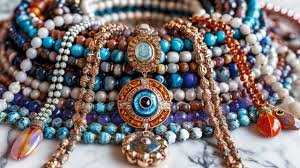
The evil eye is a belief deeply rooted in various cultures, spanning across the Middle East, Mediterranean, Asia, and even parts of Latin America. Many people believe that a malicious glance, whether intentional or not, can bring harm, misfortune, or bad luck. To ward off these negative effects, evil eye charms have become widely used symbols of protection. This blog will explore how these charms are thought to work, differentiate common myths from reality, and delve into their true cultural significance. In the sections that follow, we will examine the origins, meanings, and real-life impact of evil eye charms.
What Is the Evil Eye?
The Evil Eyes Charm is a belief that has persisted for thousands of years. It centers around the idea that a malevolent glare, often fueled by envy or ill intent, can cause harm to the person being looked at. This harm may manifest in various ways, including physical ailments, bad luck, or emotional distress.
Historical Origins:
- The belief in the evil eye dates back to ancient civilizations.
- Early mentions of the evil eye can be found in Mesopotamian, Greek, and Roman
- It was considered a powerful and mysterious force that could be projected consciously or unconsciously.
Cultural Views on the Evil Eye:
- Middle Eastern and Mediterranean Cultures: The evil eye is widely feared. People often use charms or amulets to protect themselves.
- Latin American Beliefs: Known as “mal de ojo,” it’s particularly feared for its effect on infants.
- Asian Perspectives: In countries like India and Turkey, the evil eye is also a prevalent concern, with unique protective symbols.
Each culture has its own interpretation, but the central theme remains the same: a look of envy or malice can bring bad luck.
How Evil Eye Charms Are Believed to Work
Evil eye charms, often referred to as amulets or talismans, are believed to provide protection against the harmful effects of the evil eye. These charms are not only deeply symbolic but are also thought to act as a shield, reflecting negative energy to the sender or neutralizing it altogether.
Protective Mechanism:
At the core of the belief is the idea that charm acts as a barrier. When a person wears or carries an evil eye charm, it is thought to “absorb” or “deflect” the malevolent energy that comes from a harmful glance. This prevents the individual from experiencing the misfortune or physical harm commonly associated with the evil eye.
How It Works:
- The charm “catches” the negative energy.
- It is believed that the charm can break or become damaged when it has absorbed too much harmful energy, indicating it has served its purpose.
- Some cultures believe the wearer should regularly cleanse or replace the charm to maintain its effectiveness.
Types of Evil Eye Charms:
There are several types of evil eye charms, each with unique designs and meanings. While the symbolism may vary slightly from culture to culture, the overall purpose remains the same — protection from harm.
Common Types Include:
- Blue Glass Beads: These are the most recognized form of evil eye charms, especially in the Mediterranean and Middle Eastern regions. The blue color is thought to be protective and reflective.
- Hamsa Hand: A hand-shaped charm, often featuring an eye in the center. It is commonly used in Jewish and Islamic traditions and represents protection from evil forces.
- Red String Bracelets: In some cultures, especially within the Jewish Kabbalah tradition, red strings are used to ward off the evil eye. These are tied around the wrist and believed to bring protection.

Symbolism of Colors and Shapes:
Evil eye charms are often created in different colors and shapes, each with its own symbolic meaning. While the most common is the blue eye, other variations exist that cater to specific protective needs or cultural beliefs.
Common Colors and Their Meanings:
- Blue: Represents protection, peace, and spiritual calm.
- Green: Associated with personal growth, balance, and healing.
- Red: Often linked to strength and protection against physical harm.
- Black: Believed to offer power and protection from unseen forces.
Shapes:
- Eye Shape: The most iconic form of the evil eye charm, thought to represent the gaze reflecting negative energy to its source.
- Hand Shape (Hamsa): Symbolizes strength and blessing, offering protection from both the evil eye and other misfortunes.
Each shape and color adds a layer of meaning, believed to enhance the charm’s protective abilities based on the wearer’s specific needs.
Myths Surrounding Evil Eye Charms
Evil eye charms have been surrounded by many myths over the years. These beliefs, often passed down through generations, influence how people use and view the charms. While some myths are still widely accepted, others are misunderstood or exaggerated.
- Charms Must Be Gifted to Work: A common myth is that an evil eye charm only works if it’s given as a gift. While gifting the charm is a thoughtful gesture, there’s no evidence that it loses power if bought for oneself.
- They Break When They Absorb Negative Energy: Many believe that an evil eye charm will break or shatter once it absorbs enough negative energy. This myth suggests the charm has done its job and needs to be replaced, but in reality, breaking can simply be due to wear and tear.
- The Color Affects the Protection: There’s a myth that only blue evil eye charms are effective. While blue is the most traditional color, many believe charms in other colors can provide protection, each color symbolizing different forms of energy.
- Evil Eye Charms Can Reverse Bad Luck: Some people think that an evil eye charm can reverse bad luck or undo the harm that has already been done. In reality, the charm is believed to prevent negative energy, not change past events.
- One Charm Protects Against All Types of Harm: Another myth is that a single charm can protect against all types of harm. While the evil eye is believed to block negative energy from envy, it doesn’t protect all forms of danger or misfortune.
- Charms Have to Be Blessed to Work: Some believe that an evil eye charm only works if it has been blessed by a religious figure. Though blessings can add personal significance, the charm’s power is rooted in belief and cultural tradition, not necessarily a blessing.
These myths continue to shape how people use evil eye charms, but understanding the reality behind them can help clarify their true purpose. In the next section, we’ll look at what evil eye charms do and their modern-day significance.

Reality- What Evil Eye Charms Do
While many myths surround Evil Eye Jewelry, understanding what they do helps clarify their true role. These charms are believed to offer protection, but their power largely comes from cultural belief and symbolism.
- Protection from Negative Energy: Evil eye charms are thought to block harmful energy, especially the kind caused by envy or ill intentions. The charm doesn’t actively remove bad luck but serves as a shield to prevent it from affecting the wearer.
- Symbol of Faith and Belief: The effectiveness of an evil eye charm depends on the belief in its power. For many, wearing or displaying the charm provides a sense of security, even if there’s no scientific proof behind it.
- Psychological Comfort: Some people experience peace of mind when wearing an evil eye charm. The belief that they are protected helps reduce anxiety about negative influences, creating a sense of calm.
- Cultural Tradition: In many cultures, evil eye charms are part of tradition and rituals. People continue to use them because they are tied to family heritage and cultural identity, passing down the protective symbol through generations.
- Connection to Positive Energy: While the focus is often on blocking negative energy, some people believe the charm attracts positive energy by keeping harmful forces away.
In reality, the power of evil eye charms lies in the cultural and personal beliefs behind them. They act as a symbol of protection and a reminder of positive energy, offering comfort to those who wear or display them.
How to Use Evil Eye Charms
Evil eye charms are believed to offer protection from negative energy, and how you use them can depend on personal preference or cultural tradition. While their power is rooted in belief, there are common ways to use them effectively for protection.
- Wear as Jewelry: One of the most popular ways to use an evil eye charm is by wearing it as jewelry. Necklaces, evil eye bracelets, rings, and earrings with the evil eye symbol keep the charm close to your body, which is thought to offer constant protection throughout the day.
- Hang in Homes: Many people place evil eye charms in their homes to guard against negative energy. Hanging the charm near the front door or in a window is believed to prevent bad luck from entering the home.
- Carry with You: If you don’t want to wear the charm, you can carry it with you in a bag, wallet, or pocket. Keeping it nearby is thought to provide similar protection as wearing it, helping block any negative energy wherever you go.
- Use in Vehicles: Evil eye charms are often hung inside cars to protect against accidents and road mishaps. This is a common practice in many cultures, as the charm is believed to shield travelers from harm.
- Gift to Others: In some cultures, gifting an evil eye charm is considered an act of goodwill. Giving the charm to someone you care about is thought to extend protection to them, strengthening the bond between giver and receiver.
Evil eye charms are surrounded by myths, but the reality is that their power comes from personal belief and cultural symbolism. While they may not have scientific proof, their psychological comfort and significance in many cultures cannot be ignored. When using an evil eye charm, it’s important to reflect on your own beliefs and traditions, as these will shape how you view its protective qualities. Ultimately, understanding the charm beyond myths allows you to appreciate its true meaning and the personal sense of security it provides.





